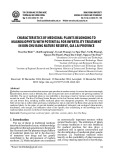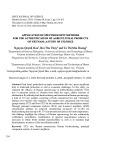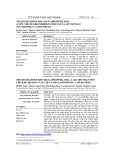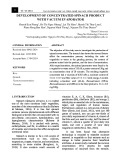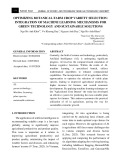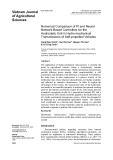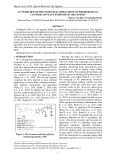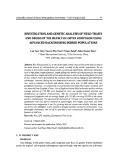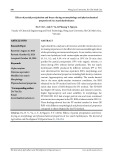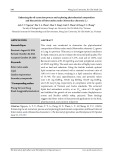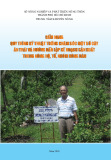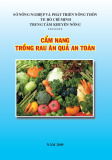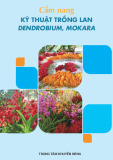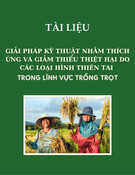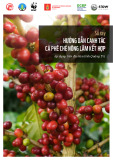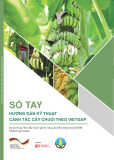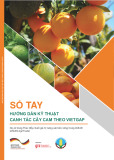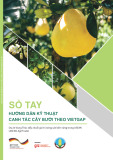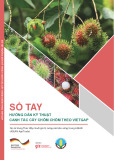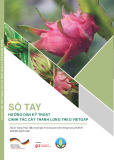
Int.J.Curr.Microbiol.App.Sci (2020) 9(4): 921-928
921
Original Research Article https://doi.org/10.20546/ijcmas.2020.904.110
Microbial Activity as Influenced by Sunflower Residue Incorporation,
Method of Establishment and Nutrient Management of Rice in Rice-
Greengram Sunflower Cropping System in Odisha, India
Tapas Ranjan Sahoo1*, R. K. Paikaray1, K. N. Mishra2 and B. S. Rath3
1Department of Agronomy, College of Agriculture, OUAT, Bhubaneswar, India
2Department of Soil Science and Agril Chemistry, College of Agriculture, OUAT, India
3Department of Agril Meteorology, College of Agriculture, OUAT, Bhubaneswar, India
*Corresponding author
A B S T R A C T
Introduction
Rice and rice based cropping systems are of
prime importance for food security mainly in
South and South East Asia. Rice and pulses
are the major portion of the human diet. With
growing concern about human health, soil
quality and environmental safety, need has
been felt to reevaluate over the existing
agricultural practices viz. continuous
monocropping which has led to decline or
stagnation of productivity due to deterioration
of soil physio-chemical properties. This
problem can be partly overcome with more
focus on agricultural practices such as green
manuring, recycling of crop residues, and
International Journal of Current Microbiology and Applied Sciences
ISSN: 2319-7706 Volume 9 Number 4 (2020)
Journal homepage: http://www.ijcmas.com
A field experiment was conducted at main research farm of OUAT, Bhubaneswar,
Odisha. The experiment was laid out in double split design with 27 treatment
combinations and three replications. In main plot sunflower residue was removed
in one plot, incorporated in another plot and in third plot no sunflower was grown.
In subplot three methods of establishment of rice was taken namely dry direct
seeded, wet direct seeded and transplanting method of rice establishment. Three
different nutrient management practices was given to rice in sub sub plot i.e. first
is fully organic where only FYM was used as nutrient source, in second one
integrated approach was followed through 75 percent of nitrogen through
inorganic nutrient source with 25 percent of organic source and the third case is
pure inorganic where only chemical fertilizer was given at the rate of 60-30-30 kg
of N-P2O5-K2O per ha. After harvest of rice, green gram crop was taken under
residual soil moisture and soil nutrient status. Dehydrogenase activity,
phosphatase activity, urease activity and total microbial biomass carbon were
higher in sunflower residue incorporation and organic source of nutrient.
Keywords
Microbial activity,
Dehydrogenase,
Urease,
Phosphatase, MBC
Accepted:
10 March 2020
Available Online:
10 April 2020
Article Info

Int.J.Curr.Microbiol.App.Sci (2020) 9(4): 921-928
922
inclusion of legumes in rotation. The selection
of component crops needs to be suitably
planned to harvest the synergism among them
towards efficient utilization of resource base
and to increase overall productivity.
Crop sequencing can put emphasis on
synergistic interactions among crops (Tanaka
et al., 2005). Inclusion of legume in the
cropping system definitely improves the soil
physic chemical and biological properties.
Also incorporation of crop residue in the soil
improves the soil organic carbon. Another
aspect of crop residue management is its
effect on the microbial community that
regulates soil health. The microbes mineralize
organic matter and release essential nutrients
into the soil enabling the biogeochemical
processes.
Despite well-known role of microbes in the
soil, not much impetus has been laid to study
their activity through different enzymatic
activity under crop residue management.
Source of nutrient also has impact on
microbial activity. As we know, organic
source of nutrient has direct impact on the soil
microbial activity as this acts as ready source
of carbon for their growth and development.
An attempt has been made to evaluate the
effect of source of nutrients in rice on
microbial activity in rice-sunflower-
greengram system.
Materials and Methods
The experiment was conducted at main
research farm of OUAT, Bhubaneswar,
Odisha. The experiment was laid out in
double split design with 27 treatment
combinations and three replications. In main
plot sunflower treatment was taken, in first
plot sunflower was grown only, in second plot
sunflower was grown along with
incorporation of the sunflower residue and the
third main plot was taken as control where no
sunflower was grown. After sunflower rice
was taken in the sub plot with three
established methods as dry direct sowing, wet
direct sowing and transplanted.
Three different nutrient management practices
was given to rice in sub sub plot i.e. first is
fully organic where only FYM was used as
nutrient source, in second one integrated
approach was followed through 75 percent of
nitrogen through inorganic nutrient source
with 25 percent of organic source and the
third case is pure inorganic where only
chemical fertilizer was given at the rate of 60-
30-30 kg of N-P2O5-K2O per ha.
After harvest of rice, green gram crop was
taken under residual soil moisture and soil
nutrient status. The variety used for rice was
Naveen. The dehydrogenase activity in the
soil samples was determined by following the
procedure as described by Casida et al.,
(1964).
Phosphatase activity of soil samples was
determined by following the procedure of
Evazi and Tabatabai (1979). The procedure
adopted to determine the urease activity of
soil was essentially the same as adopted by
Pancholy and Rice (1973) except that the
ammonia liberated due to hydrolysis used in
the reaction mixture was determined by
nesslerization as described by Jackson (1973).
The microbial biomass carbon (Cmic) was
determined by chloroform fumigation –
extraction method as described by Vance et
al., (1987).
Results and Discussion
The data on dehydrogenase activity (μg TPF
g-1 soil day-1) as influenced by sunflower
residue incorporation, method of
establishment and source of nutrient has been

Int.J.Curr.Microbiol.App.Sci (2020) 9(4): 921-928
923
presented in Table 1. During 2016-17, before
growing sunflower crop, there was no
significant difference in dehydrogenase
activity in the bulk soil.
Before growing rice as well as greengram,
dehydrogenase activity was significantly
higher in the plot where sunflower residues
were incorporated. Before greengram, the
dehydrogenase activity was as high as 72.08
μg TPF g soil-1 day-1.
Among the methods of establishment, there
has been no significant difference in
dehydrogenase activity before different crops.
But, numerically higher dehydrogenase
activity was seen in case of dry direct sowing
before all the crops.
There was significant difference in
dehydrogenase activity among the various
sources of nutrient. Organic source of nutrient
resulted in highest dehydrogenase activity
before all the crops in both the years followed
by 75% RDF+25 % organic and RDF.
The interaction effect was found to be non
signif.The data on acid phosphatase activity (
μmol paranitrophenol g soil-1 hr-1) as
influenced by sunflower residue
incorporation, method of establishment and
source of nutrient before growing various
crops has been presented in Table 2.
Before growing sunflower crop, there was no
significant difference in phosphatase activity
in the bulk soil. Before growing rice as well
as greengram, phosphatase activity was
significantly higher in the plot where
sunflower residues were incorporated. Before
greengram, the phosphatase activity was 1.94
μmol paranitrophenol g soil-1 hr-1.
There has been no significant difference in
phosphatase activity before different crops
among the methods of establishment. But,
numerically higher phosphatase activity was
observed in wet direct sowing before all the
crops.
There was no significant difference in
phosphatase activity among the various
sources of nutrient during 2016-17. The
interaction effect was found to be non
significant.
The results of the analysis on acid urease
activity ( μg NH+ g soil-1 hr-1) as influenced
by sunflower residue incorporation, method
of establishment and source of nutrient before
growing various crops has been presented in
Table 3.
Before growing sunflower crop in the first
year, there was no significant difference in
urease activity in the bulk soil. Before
growing rice as well as greengram, urease
activity was significantly higher in sunflower
residues incorporated plot. Before greengram,
the urease activity was 31.27 μg NH+ g soil-1
hr-1.
Among the methods of establishment, there
has been no significant difference in urease
activity before different crops. But,
numerically higher urease activity was
observed in wet direct sowing before all the
crops.
There was no significant difference in urease
activity among the various sources of nutrient
during 2016-17 before growing sunflower and
rice. Before greengram, urease activity was
highest in organic source of nutrient (27.60 μg
NH+ g soil-1 hr-1). The interaction effect was
found to be non significant.
The results of the analysis on MBC ( μg C g
soil-1) as influenced by sunflower residue
incorporation, method of establishment and
source of nutrient before growing various
crops has been presented in Table 4.

Int.J.Curr.Microbiol.App.Sci (2020) 9(4): 921-928
924
There was no significant difference in MBC
in the bulk soil. Before growing rice as well
as greengram, urease activity was
significantly higher in sunflower residues
incorporation plot. Before greengram, the
maximum MBC was 187.09 μg C g soil-1 in
residues incorporation plot.
There has been no significant difference in
MBC before different crops among the
methods of establishment. But, numerically
higher MBC was observed in transplanting
before all the crops. There was no significant
difference in MBC among the various sources
of nutrient before growing sunflower and rice.
Before greengram, MBC was highest in
organic source of nutrient (173.65 μg C g soil-
1). The interaction effect was found to be non
significant.
Dehydrogenase activity was significantly
higher in sunflower residues incorporation.
Before growing rice as well as greengram,
phosphatase activity was significantly higher
in the plot where sunflower residues were
incorporated. So also urease as well as total
microbial biomas carbon were higher in the
plot where sunflower residue was
incorporated.
This might be due to incorporation of crop
residue acted as organic carbon source for
higher growth of microbes leading higher
activity of soil enzymes and higer value of
total microbial biomass carbon. Jilani et al.,
(2007) revealed that the organic amendments
hold great promise as a source of multiple
nutrients and ability to improve soil
characteristics.
Biochemical compounds resulting from the
mineralization of organic residues or litter
also render great impact on soil
microorganisms. The incorporation of crop
residues into the soil modifies its chemical
and biochemical properties, including soil-
enzyme activity , the behaviour of which has
often been related to the amount as well as to
the type of organic matter. Addition of
tobacco and sunflower residues in soil
increases the activities of most of the soil
enzymes, while tomato residues increased
only the amylase and phosphodiesterase
activities (Perucci et al., 1984).
Dehydrogenase activity during decomposition
of sunflower residues was higher in first week
after that it declined (Kaur and Kapoor,
2000). There was no significant difference in
microbial activity indicators with respect to
methods of establishment.
Organic source of nutrient resulted in highest
dehydrogenase activity before all the crops
followed by 75% RDF+25 % organic and
RDF. Similar trend was also observed for
phosphatases activity ,urease activity and
total microbial biomas carbon. The findings
are in conformity with findings of Verma et
al., (2019).
The supply of additional mineralizable and
readily hydrolysable C due to organic manure
application results in higher microbial activity
and higher microbial biomass carbon (Ingle et
al., 2014). The enzyme activities in the soil
are closely related to organic matter content
and greater activities of dehydrogenase, in
this treatment may also be due to enhanced
microbial activity.
Application of balanced amount of nutrients
and manure improve the microbial biomass
carbon status of soil which corresponds to
higher enzyme activity (Mandal et al., 2007).
Organic matter can provide substantial
nutrients for microorganism growth and
reproduction. So rice straw incorporation in
rice –wheat cropping system significantly
increased MBC, MBN and improved the
urease, invertase, and catalase activities (Zhao
et al., 2019).

Int.J.Curr.Microbiol.App.Sci (2020) 9(4): 921-928
925
Table.1 Dehydrogenase activity as influenced by various treatments
Treatment
Dehydrogenase activity (μg TPF g soil-1 day-1)
Sunflower
Sunflower
Sunflower
Sunflower residue
Removal
47.74
51.81
64.81
Incorporation
47.36
56.58
72.08
Control
47.68
48.81
50.83
S.Em.±
0.32
0.21
0.23
CD(0.05)
NS
0.71
0.79
Method of establishment
Dry direct sowing
48.08
52.20
62.87
Wet direct sowing
48.03
52.81
62.95
Transplanting
46.68
52.26
61.91
S.Em.±
0.19
0.16
0.27
CD(0.05)
NS
NS
NS
Source of nutrient
Organic(100 % N FYM)
47.63
52.22
65.52
75% RDN+25 % N Organic
47.72
52.67
61.81
RDF
47.45
52.38
60.41
SEm±
0.24
0.23
0.23
CD(0.05)
NS
NS
0.64
Table.2 Phosphatase activity as influenced by various treatments
Treatment
Acid phosphatases activity (μmol paranitrophenol g soil-1 hr-1)
Sunflower
Sunflower
Sunflower
Sunflower residue
Removal
0.99
1.23
1.61
Incorporation
0.99
1.47
1.94
Control
0.98
1.12
1.87
S.Em.±
0.05
0.01
0.01
CD(0.05)
NS
0.03
0.03
Method of establishment
Dry direct sowing
1.01
1.25
1.77
Wet direct sowing
0.99
1.26
1.83
Transplanting
0.97
1.31
1.82
S.Em.±
0.018
0.01
0.01
CD(0.05)
NS
NS
0.03
Source of nutrient
Organic(100 % N
FYM)
0.99
1.27
1.68
75% RDN+25 % N
Organic
0.99
1.28
1.80
RDF
0.99
1.28
1.94
SEm±
0.012
0.01
0.01
CD(0.05)
NS
NS
0.02

